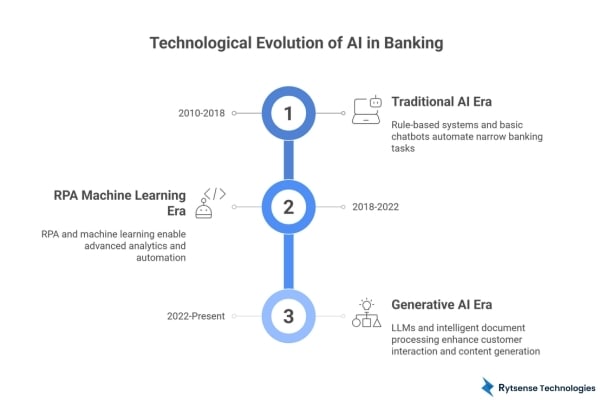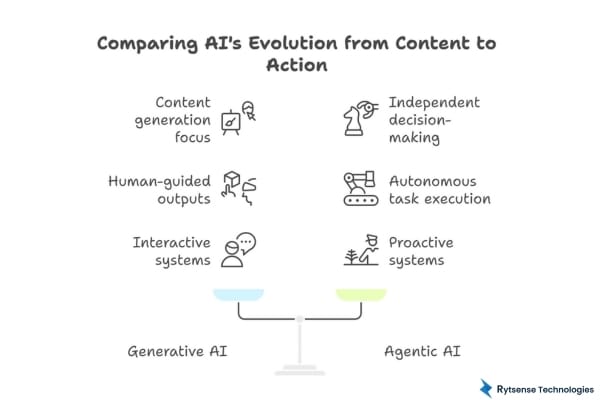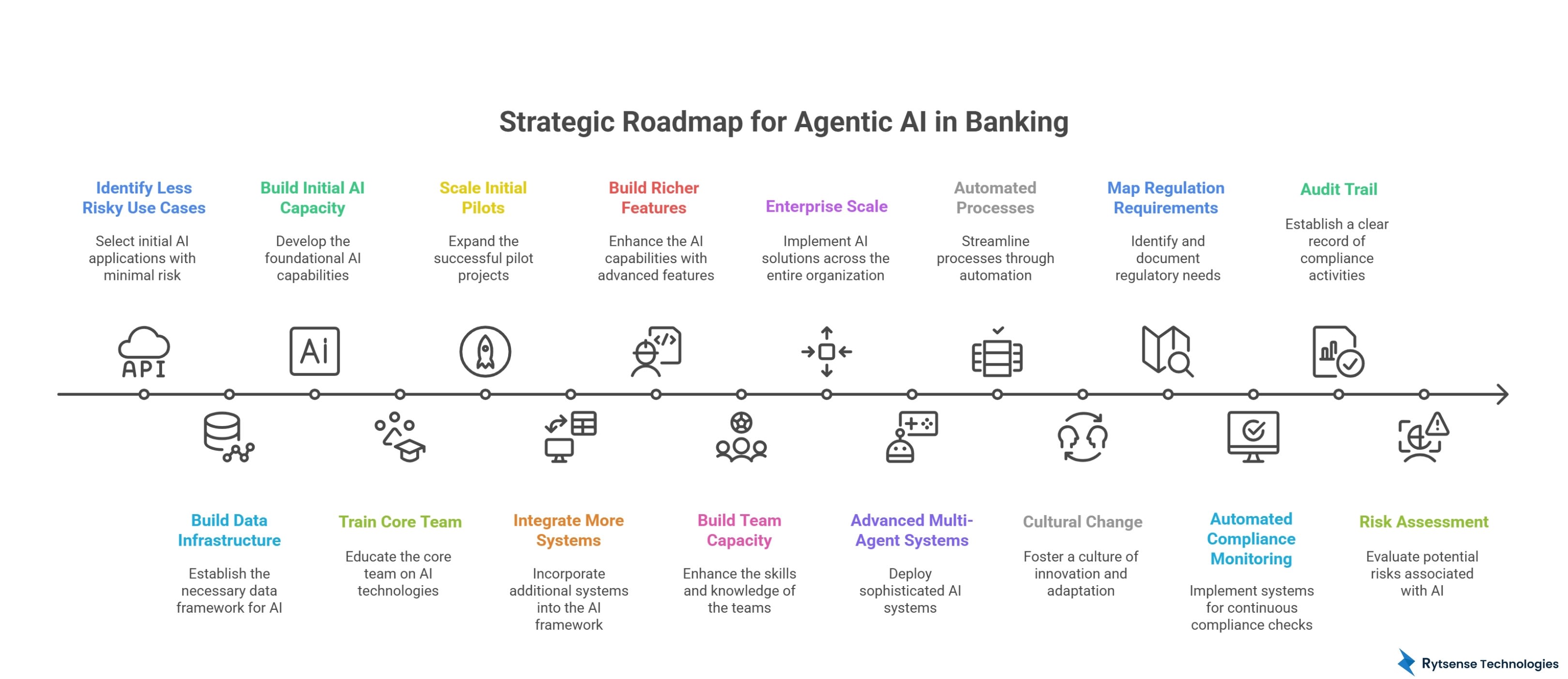-
Key Takeaways
- Agentic AI enables autonomous banking operations with 40% faster processing and 65% cost reduction.
- Priority use cases include automated credit decisions, fraud detection, and customer onboarding with 6-18 month ROI.
- Success requires robust governance, regulatory compliance, and human oversight to mitigate AI risks.
- Implementation should start with pilot projects, then scale enterprise-wide with dedicated AI-compliance teams.
- Future banking will feature autonomous AI agents delivering invisible, personalized financial services.
Agentic AI in Banking: Transforming the Future of Financial Services
Overview Agentic AI in Banking
This section offers a thorough overview of agentic AI technology within the context of banking by defining essential terminology and outlining how autonomous AI systems are critical to competitive strategy and operational effectiveness for any modern financial institution.
What is Agentic AI?
Agentic AI is a form of AI that can take independent action to achieve a specific goal, without constant human supervision. An agentic AI agent may perceive its environment, make decisions, take action, and learn from its experience. Specifically, in banking, agentic AI systems can understand rich financial scenarios, interact with many different systems, and take action across several different departments.
Key Characteristics of agentic AI include:
- Autonomy: Act independently from human action
- Goal-directed behavior: Work towards a specific goal
- Situational awareness: Know context of the situation
- Learning: Learn from experience
- Decision-making: Make decisions based on available data
Why Agentic AI in Banking Matters Today
- Cutting operational expenses by 30-50% through automation
- Providing an exceptional customer experience through 24/7 non-invasive assistance
- Allowing for enhanced real-time risk monitoring
- Speeding up organizational decision making
- Providing automatic regulatory compliance
The Evolution of AI to Agentic AI in Banking

From Traditional AI and RPA to Generative AI
The Era of Traditional AI (2010-2018):
- Rule-based systems for basic automation
- Simple chatbots with limited human-like response capabilities to answer customer inquiries
- Basic directives for possible fraudulent determination
- Limited to discrete, narrow based work
RPA Machine Learning Era (2018-2022):
- Robotic Process Automation doing repetitive tasks
- Machine learning coding for pattern recognition
- Advanced analytics for simple loan risk assessment
- Built upon legacy bank systems
Generative AI Era (2022-Present):
- Large language models based from Natural Language Processing on large datasets
- Content generation for reports, communications, and loan applications
- More customer interactivity
- Intelligent document processing.
How Agentic AI in Banking Represents the Next Leap
| Traditional AI | Generative AI | Agentic AI |
|---|---|---|
| Rule-based responses | Content generation | Independent decision-making |
| Human-triggered actions | Human-guided outputs | Autonomous task execution |
| Single-purpose tools | Multi-modal capabilities | Multi-agent orchestration |
| Reactive systems | Interactive systems | Proactive systems |

Ready to revolutionize your banking operations with intelligent automation?
Discover how Agentic AI can reduce costs and enhance customer satisfaction for your institution.
Top Use Cases of Agentic AI in Banking
| Use Case | Key Functions | Benefits | Implementation Complexity |
|---|---|---|---|
| Credit Underwriting & Loan Decisioning | Real-time data analysis, risk assessment, automated approvals, continuous monitoring | 80% faster processing 25% reduction in defaults Improved accuracy |
High |
| Payments & Transaction Automation | Payment routing optimization, failure resolution, compliance management, FX optimization | 60% faster settlements Reduced operational costs Improved success rates |
Medium |
| Fraud Detection & AML | Real-time monitoring, pattern recognition, suspicious activity detection, automated reporting | 90% reduction in false positives Faster threat detection Regulatory compliance |
High |
| Legal & Compliance Management | Automated reporting, contract analysis, policy monitoring, regulatory change tracking | 70% reduction in compliance costs Improved accuracy Risk mitigation |
Medium |
| Customer Onboarding & Services | KYC automation, document verification, personalized recommendations, 24/7 support | 50% faster onboarding Enhanced customer experience Reduced manual work |
Low-Medium |

Smarter Credit Underwriting & Loan Decisioning
- Access data sources related to credit histories, bank statements, and alternative data
- Leverage algorithms to assess risk factors
- Make lending decisions within minutes instead of days
- Monitor borrower actions after the loan is funded
- Adjust credit related to changes in users’ actions
Advantages:
- Reduction in loan processing times by 80%
- Savings generated by reduced default rates of 25%
- Improved precision of risk assessment actions
- Improved user satisfaction
Payments & Transaction Automation
- Automatically route payments through best payment management channels
- Detect payment failures, and resolve
- Document compliance for cross-border transactions
- Improve foreign exchange rates
- Handle payment disputes automatically
Fraud Detection and Anti-Money Laundering (AML)
- Real time transaction monitoring
- Pattern analysis in multiple accounts
- Detection and reporting of suspicious activity
- Automated reports for regulatory compliance
- Risk scoring and prioritization of alerts
Use cases for agentic AI in banking to prevent fraud include:
- Behavioral biometrics analysis
- Network analysis for detection of money laundering
- Real time risk scoring
- Automated suspicious activity reports
Legal, Compliance & Risk Management
- Automatic reporting to regulators
- Contract analysis and risk assessment
- Policy monitoring and updates
- Audit trail
- Regulatory changes
Financial risk management with AI provide:
- Market risk
- Credit risk monitoring
- Operational risk
- Stress testing
- Capital adequacy
Customer Onboarding & Personalized Services
- Automated Know Your Customer processes
- Verifying and validating documents
- Risk profiling and recommending products
- Personalized banking with AI agents
- 24/7 support
Deployment Strategies for Agentic AI in Banking
Overlaying Agentic AI on Existing Systems
Pros:
- Lower cost to implement
- Limited disruption to current operations
- Rapidly get to market
- Integrating into existing workflows with lower complexity
Steps:
- Identify viable processes for AI overlay
- Build API connectors to legacy systems
- Train the AI agents using current data
- Launch using a phased rollout approach
Building Agentic AI by Design in Banking
- Banks adopting a cloud-native stack
- Has got Microservices architecture
- API-first design may ensure scalability while compliance maintenance
- Security infrastructure of Banking is integrated
Reimagining Banking Processes with Agentic AI
| Traditional Process | Agentic AI Enhanced Process |
|---|---|
| Manual document review | Automated intelligent analysis |
| Sequential approval chains | Parallel processing with AI agents |
| Static risk models | Dynamic, self-updating algorithms |
| Reactive customer service | Proactive problem resolution |
Want to see how Agentic AI can streamline loan approvals, detect fraud, and improve compliance — all at once?
Our tailored AI systems make it possible.
Technology Ecosystem Enabling Agentic AI in Banking
Platforms and Frameworks
- Microsoft Azure AI: An entire suite of tooling and services for AI
- AWS Bedrock: Foundation models and infrastructure for AI
- Google Cloud AI: Advanced machine learning capabilities
- IBM Watson: Enterprise-level AI solutions
- Rytsense: Offering specific agentic AI in financial servicesspace
Rytsense specifically offers up-to-date agentic AI platforms developed for banking institutions, with pre-built AI agents for common banking activities, enhanced tools to assist with regulatory compliance, and support for connections to other systems.
Multi-Agent Systems and Orchestration
- Customer Service Agents: Respond to inquiries and provide assistance.
- Risk Management Agents: Monitor risk and evaluate risk factors.
- Compliance Agents: Facilitate adherence to regulatory requirements.
- Transaction Processing Agents: Carry out payments and transfers.
- Analytics Agents: Create reports and other insights.
Data, Infrastructure, and Integration Needs
Data Requirements:
- Adequately cleaned data from a data storage engine.
- Capability to stream data in near real-time.
- Ongoing data quality management.
- Ability to process data in a privacy-preserving way.
Infrastructure Requirements:
- Access to performant and high-computing capabilities.
- A highly scalable cloud infrastructure.
- Application security frameworks.
- API management features.
Risks and Governance of Agentic AI in Banking
Ethical, Regulatory & Compliance Challenges
Regulatory Challenges
- AI regulatory compliance challenges
- Data privacy obligations
- Algorithmic transparency mandates
- Cross-border regulatory differences
Ethics Issues:
- Bias in AI processes decision making
- Fair lending practices
- The protection of customer data
- Algorithmic accountability
Model Risks, Interpretability, and “Rogue” Behaviors
- Model drift: AI losing its efficiency over time
- Unexpected behaviors: agents emerging outside of the founders’ parameters
- Interpretability: Diminished capacity of explaining AI’s decision making
- Systemic risks: network effects of AI failures
Human Oversight and Governance Mechanisms
- Multi-level oversight: Monitoring of the AI takes place through the technical, business, and compliance teams that created it.
- Continuous monitoring: AI performance should be monitored, including real time controls at the lowest available level of risk.
- Escalation protocols: Gaps in the project-management approach to risk should be communicated as a prevention of action of AI failure.
- Regular audits: Periodic reviews and risk assessments should take place periodically of the system.
- Training programs: The staff that oversees or manages the AI should also be provided opportunities to learn about the AI system.
Strategic Roadmap for Agentic AI in Banking

Starting Small with Pilot Projects
Phase 1: Establishment (3–6 months)
- Identify less risky use cases
- Build the data infrastructure
- Build the initial AI capacity
- Train the core team
Phase 2: Growth (6–18 months)
- Scale the initial pilots
- Integrate more systems
- Build out richer features
- Build the capacity of the teams
Stage 3: Transformation (18+ months)
- Enterprise scale
- Advanced multi-agent systems
- Automated processes
- Cultural change
Embedding Compliance from Day One
- Mapping regulation requirements
- Automated compliance monitoring
- Audit trail
- Risk assessment
Building AI-Compliance Collaboration Teams
- AI/ML engineers
- Compliance officer
- Risk manager
- Business representatives
- Legal council
Change Management & Cultural Shifts
- Executive leadership
- Employee training
- Clear communication
- Performance metrics
- Continuous feedback loops
The Future Outlook of Agentic AI in Banking
How Retail and SME Banking Will Transform?
Agentic AI for retail banking will provide:
- Hyper-personal financial advice
- Automated financial planning
- Dynamic spending optimization
- Proactive financial health monitoring
Agentic AI in SME Banking will provide:
- Automated cash flow management.
- Intelligent loan structuring.
- Supply chain finance optimization.
- Risk-based pricing based models.
Competitive Landscape & Market Implications
- Reduction of operational costs.
- Improvement of customer experience.
- Faster product and service delivery and overall innovation.
- Improvement of risk management.
Towards Autonomous and Invisible Banking
- Autonomous AI in financial services
- Invisible banking experiences.
- Self-directed AI in finance (money management).
- Proactive AI orchestration in financial services
Conclusion
The technology promises to change everything from customer onboarding to risk management, with early adopters showing significantly improved operational efficiency and customer satisfaction already. Successful implementation will require careful planning and sufficient governance frameworks while facilitating ethical applications of AI.
Organizations such as Rytsense are leading this transformation with companies to provide specialized solutions for banks to utilize in their own systems for use in agentic AI, regulatory adherence, and improved risk management through operational efficiency.
The journey of autonomous banking and intelligent banking has begun, and the banks adopting agentic AI today will be best positioned in the financial industry of the future. Success will require a combination of meaningful implementation of AI, including ongoing learning and adaptability, along with being responsible when deploying AI to achieve business objectives and maintain customer-centric approaches.
The future of banking is autonomous. Don’t get left behind — partner with Rytsense Technologies to bring Agentic AI into your financial ecosystem and unlock next-level efficiency and innovation.
Meet the Author

Karthikeyan
Co-Founder, Rytsense Technologies
Karthik is the Co-Founder of Rytsense Technologies, where he leads cutting-edge projects at the intersection of Data Science and Generative AI. With nearly a decade of hands-on experience in data-driven innovation, he has helped businesses unlock value from complex data through advanced analytics, machine learning, and AI-powered solutions. Currently, his focus is on building next-generation Generative AI applications that are reshaping the way enterprises operate and scale. When not architecting AI systems, Karthik explores the evolving future of technology,where creativity meets intelligence.